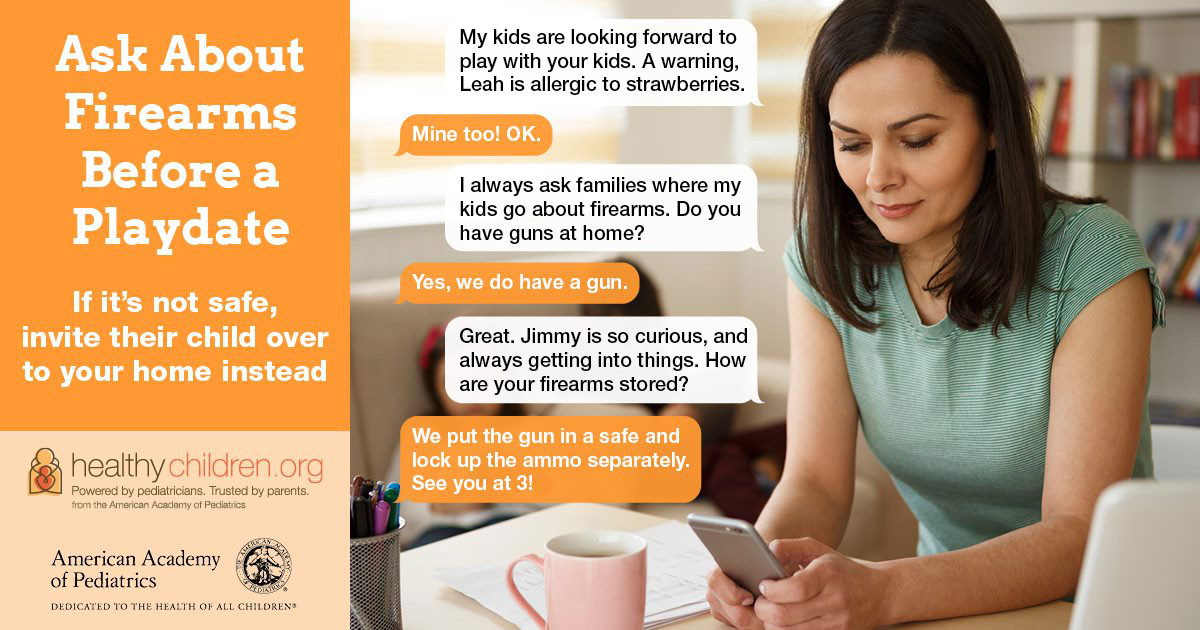By: Judy Schaechter, MD, MBA, FAAP
Did you know that roughly a third of U.S. homes with children have guns? In fact, an estimated 4.6 million kids live with unlocked, loaded guns. That's a scary statistic when you think about the fact that even young toddlers are capable of finding unlocked guns in the home, and they are strong enough to pull the trigger.
As a parent, you may not realize what a serious risk a gun in the home is, especially for children.
Firearms are now the leading cause of death for U.S. children and teens under the age of 18. And the reality is that having firearms in the home increases the risk of unintentional shootings, suicide and homicide. Read on to learn how to keep your child safe.
Unintentional shootings & gun injuries
Unintentional shootings happen to children of all ages. The two age groups most likely to unintentionally shoot themself or others are high schoolers between 14 and 17 years old, followed by preschoolers ages 5 and younger.
Research shows that about half of unintentional firearm injury deaths among children and teens between 2001 and 2021 took place in their homes—usually when the kids were playing or showing the gun someone else. Many had accessed the firearm, usually a handgun, from a nightstand or other sleeping area.
Between 2015 and 2023, there were at least 3,200 unintentional shootings by children age 17 and younger. These resulted in 1,200 deaths and 1,815 nonfatal gun injuries, nearly all among other kids. And at least 1,000 preschoolers and toddlers managed to find a gun and unintentionally shoot themselves or someone else, often a sibling or friend, during this time.
Suicide risk with guns in the home
Kids and teens are at an increased risk for
suicide when there is a gun in the home too. Suicide rates in this population are four times higher than for those who live in homes without guns. In roughly the past decade, 40% of children and teens who died by suicide used guns. Nine out of 10 of these suicides were with guns that the victims accessed at their own homes or from a relative's home.
Guns, kids & homicides
The risk of homicide is three times higher when there are guns in the home. Not only that, but 58% of shooting deaths in children and teens are homicides.
The most effective way to keep kids safe
The American Academy of Pediatrics (AAP) advises that the safest home for a child is one without guns. The most effective way to prevent unintentional gun injuries, suicide and homicide to children and adolescents, research shows, is the absence of guns from homes and communities.
What to do if you do keep a gun in your home
If you decide to keep guns in the home, be aware that many studies show that teaching kids about gun safety, or to not touch a firearm if they find one, is not enough. You can reduce the chances of children being injured, however, by following important safety rules:
Safe gun storage
All guns in your home should be
locked and unloaded, with ammunition locked separately. Make sure children and teens can't access the keys or combinations to lock boxes or gun safes. And remember not to keep loaded, unlocked guns in the car, or anywhere else on your property, either.
Safety steps when using firearms
When using a gun for hunting or target practice, keep the safety catch in place until you are ready to fire it. Before setting the gun down, always unload it. As much as a child may want to take a turn shooting, this is not a good idea. No matter how much instruction you may give about how to safely shoot a gun, children are not capable or responsible enough to handle a potentially lethal weapon.
How to keep your kids safe in other homes
More than a third of all unintentional shootings of children take place in the homes of their friends, neighbors or relatives. That's why it is also important to make sure your kids are safe when they spend time where other people live.

Here's how to help ensure your children and their playmates do not come across an unsecured gun while they play:
Add this question to your playdate checklist.
Even if you don't have guns in your own home,
ask about guns and safe storage at the other homes they visit. Just as you'd ask about pets, allergies, supervision and other safety issues before your child visits another home, add one more important question: "Is there an unlocked gun in your house?" If there is, reconsider allowing your child to play there or talk to them about keeping the guns unloaded and locked. (See "5 Questions to Ask Before a Playdate.")
Talk with your children about guns.
Remind your kids that if they ever come across a gun, they must stay away from it and tell you immediately.
Guns in the media
Make sure your children understand that gun violence they may see on TV, in movies, and in video games they play at home or friends' homes is not real. They need to be told—and probably reminded again and again—that in real life, children are killed and hurt badly by guns. Although the popular
media often romanticize gun use, children need to learn that these weapons can be extremely dangerous.
More information
About Dr. Schaechter:
 Judy Schaechter, MD, MBA, FAAP, is a Professor of Public Health Sciences at the University of Miami Miller School of Medicine and past president of the national Injury Free Coalition for Kids. She is a past member of the American Academy of Pediatrics Council on Injury, Violence and Poison Prevention Executive Committee.
Judy Schaechter, MD, MBA, FAAP, is a Professor of Public Health Sciences at the University of Miami Miller School of Medicine and past president of the national Injury Free Coalition for Kids. She is a past member of the American Academy of Pediatrics Council on Injury, Violence and Poison Prevention Executive Committee.
|